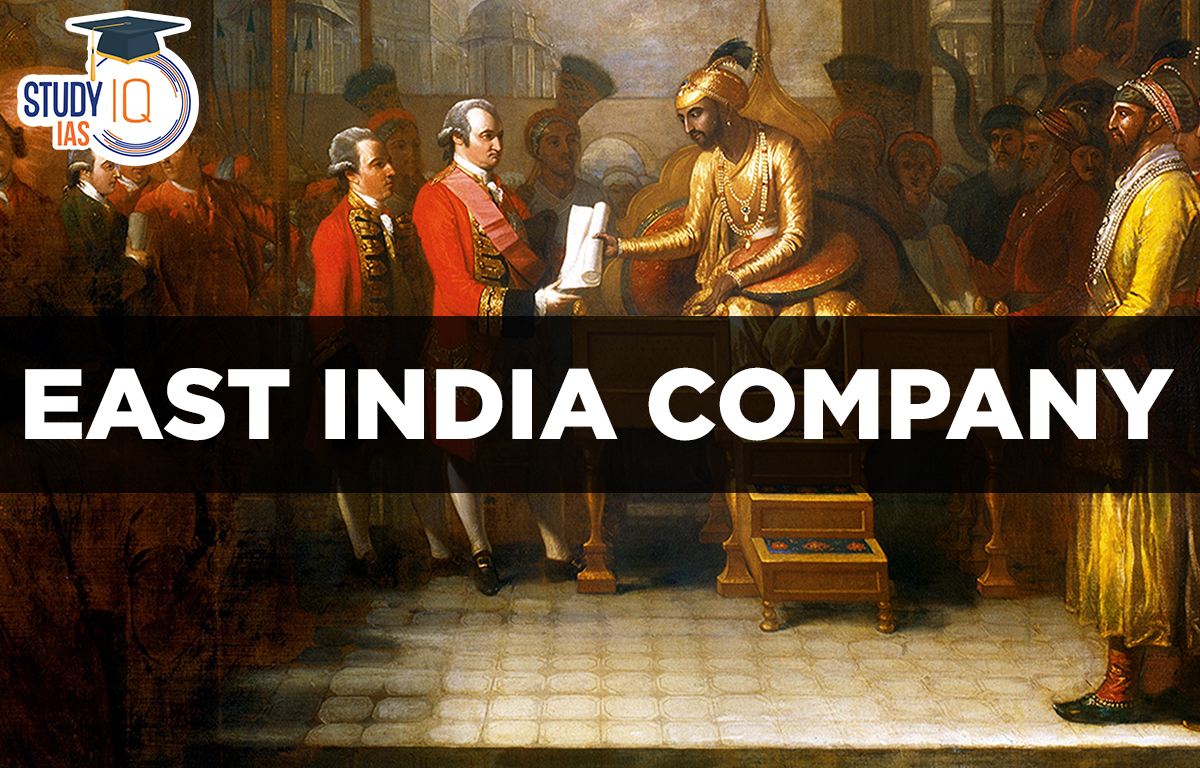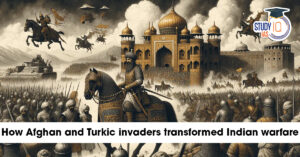Table of Contents
East India Company
East India Company: India and the west had been trading partners since the beginning of time (land route). But after the Ottoman Turks took Constantinople in 1453, they gained control of the traditional commercial routes. This compelled the Europeans to look for fresh trade routes, particularly maritime ones. Columbus, a Spaniard, headed out for India in 1492 but instead found America.
Vasco Da Gama of Portugal later established a new trade route by circumnavigating Africa in 1498. He arrived in India in Calicut, Kerala (1498), making history as the first European to enter India by sea.
The first people to establish colonies in India were the Portuguese. They could easily hold their positions against India’s strong ground armies because of their maritime superiority. They also did not have to contend with the strength of the Mughal empire because they were mostly centred in south India.
When the Dutch East India Company was established in 1602, the Dutch people were given the authority by their government to wage war, sign treaties, seize territory, and erect fortifications.
Read about: Freedom Fighters of India
East India Company History Timeline
| Timeline | Description |
| 1608 | William Hawkins established his factory with royal approval. To discuss sponsorship, he arrived at Jahangir’s court. |
| 1611 | Captain Middleton received permission from the Mughal ruler of Surat. |
| 1612 | In the Battle of Swally, Captain Thomas Best overcame the Portuguese and took control of the Sea of Surat. |
| 1613 | Aldworth began a plant in Surat after obtaining Jahangir’s approval. |
| 1632 | The East India Company set the stage for successful trading after receiving the Golden Farman from the Sultan of Golconda. |
| 1639 | After leasing it from the local king, the East India Company built Fort St. George in Madras. Built to safeguard their commerce, this fort |
| 1662 | Following his marriage to Katherine, a Portuguese princess, Charles II received Bombay as a gift. |
| 1668 | After handing Bombay to the East India Company, Charles II began getting 10 pounds annually. After this tragedy, the Company’s headquarters were moved from Surat to Bombay. |
| 1690 | To build factories, the East India Company purchased the villages of Gobindapur, Kolkata, and Sutanuti. Additionally, Fort William was built as a defensive fortification. |
| 1717 | The British East India Company received permission from the Mughal Empire’s Farrukhsiyar to reside and conduct business there through the issuance of a Farman (a trading licence). |
East India Company Growth
A group of English traders established the Merchant Adventurers in 1599 in order to conduct business in the East. In 1600, the queen granted it authorization and exclusive rights to trade with the East. Captain Hawkins received the royal farman from Mughal emperor Jahangir so he could build factories on the western shore. Later, Sir Thomas Roe was granted permission to build factories throughout the Mughal Empire.
Bombay was handed to the British by the Portuguese as dowry. In order to end the disputes between the British and the Dutch, all claims to Indonesia were renounced. The weather in the south was suitable for the English. They began at Madras by constructing Fort St. George, a fort. When the English seized Hugli and declared war on the emperor, issues started to arise. They utterly failed. The first lesson they learned was this. They continued to rely on charm and sincere appeals as they awaited their chance. Fort William was constructed and Calcutta was established in 1698. Soon, Madras, Bombay, and Calcutta developed into thriving commercial hubs.
By that time, the French under Dupleix had already arrived in India and had begun employing their well-equipped army to meddle in the affairs of the local kings. Between France and England, a war had broken out across Europe in 1742.
When the nizam passed away in 1748, his son Nasir Jung assumed the throne. Muzaffar Jung, the nizam’s grandson, confronted him. Chanda Sahib was scheming against the nawab Anwarudeen in a similar position in the Carnatic. Anwarudeen and Nasir Jung were killed when the French sided with both insurgents and successfully defended both of their positions.
The English, who were led by Muhammad Ali, a son of Anwarudeen, naturally supported the fallen. The English side eventually prevailed in the battles because to Robert Clive’s astute strategy and skill as a general. Finally, in accordance with their 1754 deal, the French called Dupleix back from India. Later, in 1760, at the Battle of Wandiwash, the French were totally wiped off. Consequently, the English continued to be India’s only rulers.
The British were able to engage in free trade in Bengal thanks to the farman that the emperor granted them. Additionally, they were not required to pay dastaks to carry these products. However, these were abused by the employees of the company, costing Bengal money. When Siraj-ud-Daulah, the grandson of Alivardi Khan, ascended to the throne in 1756, he insisted that the English engage in commerce on par with Indian traders. When the English refused and built their defenses, things got worse. Due to Mir Jaffar and Rai Durlabh’s deception, Siraj-ud-Daulah was treacherously defeated at the Battle of Plassey in 1757. The British received enormous reputation and income as a result.
Later, when Mir Jaffar was unable to pay the British the tribute they had promised, they replaced him with Mir Qasim. Being astute, he understood that fighting the British required both an army and money. Finally, he eliminated all import and export taxes. The British were enraged by this, and in 1764 they defeated Mir Qasim at the Battle of Buxar.
Regulating Act of 1773
After the East India Company had gained many new privileges, it was passed. It let the corporation to retain the territory it had acquired in India, but in light of the rising corruption discovered within the company, it tried to start controlling how the company operated. The British government was finally granted the authority to make decisions regarding Indian affairs. The position of Governor-General was created with this objective in mind. Prior to this, the Bengal area had a single governor who was responsible for overseeing the administration.
Additionally, the newly appointed governor-general had to receive reports from the governors of Bombay and Madras. It was Warren Hastings who served as India’s first governor general. A supreme court comprised of a chief justice and three additional judges was also established as a result of this act. However, the government or business employees acting in their official capacities were not subject to the court’s jurisdiction. They could not be held accountable for whatever actions they took while doing their duties.
Pitt’s India Act of 1784
Pitt’s India Act 1784: The “dual system” of control was introduced. As a result, the corporation was still permitted to maintain control over business operations and administration, but it was now a department of the British government, and the area it managed came to be known as “British holdings.” There were just 3 people left on the governor-council, general’s including the commander in chief.
To oversee the business’s civil, administrative, and military activities, a board of control was established. A secretary of state, the Chancellor of the Exchequer, and four Privy Council members made up this board.
Charter Act of 1793
The Act included the additional powers granted to the Governor-General by Lord Cornwallis in 1786. Now, the royal consent was required for the appointment of any high officials. Such an officer was not permitted to leave India without prior authorization; doing so would be seen as resigning.
The revenues of the corporation being raised in India were to be used to pay the wages of the board of council members and their personnel. Additionally, it was decided that the business would give the British government a five lakh pound payment per year. Additionally, it permitted the company’s trade monopoly in India for the following 20 years.
Charter Act of 1813
One could say that this action had a profound impact on the East India Company’s fundamental essence. The firm’s rule was once more extended by this act for the following 20 years, but the company lost its commercial monopoly in India.
However, it kept its monopoly over trade with China, opium, and tea. The missionaries have been given permission to travel to India and carry out religious proselytising. The state set aside Rs. 1 lakh to assist in the education of Indian subjects.
Charter Act of 1833
The company’s lease for revenue collection and territory control was prolonged by this act, but the company’s monopoly over commerce in tea and with China was terminated. It increased the governor-authority general’s and granted the Board of Control complete control over the Company.
The title “Governor-General of India” replaced the previous title “Governor-General of Bengal.” He was given the power to oversee, manage, and direct all of the Company’s civil and military operations. He was the sole beneficiary of all income and had full control over all outlays. Everything was conducted under his name.
To assemble and codify Indian laws, a law commission was created. The Governor-Council General’s now has four ordinary members. He was said to be an authority in lawmaking. This law granted the English the freedom to colonise India. Consequently, it effectively made the British colonial presence in India legal.
East India Company Efforts in India
Queen Elizabeth I had passed away in 1603. At about the same period, Jahangir succeeded the deceased Mughal Emperor Akbar in India (1605). As the King’s official diplomat to India, James I dispatched William Hawkins to the Court of Jahangir. Hawkins came in Surat in the “Hector” ship in 1608. But the Portuguese took this ship. Portuguese informed him that the King of Portugal owns all ports and that no one should enter without authorization. Hawkins, though, was fired for whatever reason. He arrived in April 1609 in Agra. Jahangir, the emperor, welcomed him with the full warmth and hospitality of India.
Jahangir, who affectionately referred to Hawkins as English Khan, was able to establish close ties with him. He succeeded in getting the emperor to approve a commission for an English factory in Surat, but the Portuguese Viceroy forced the emperor to revoke that approval. Hawkins attempted to overturn the choice, but the King was powerless against the Portuguese influence. In 1611, he returned in disgust and shortly passed away.
Captain Middleton was successful in obtaining approval to open a factory in Surat from the local Mughal authorities in 1611. However, he had to engage in combat with the Portuguese. In 1611 at the Battle of Bombay, he led the British to victory over the Portuguese. However, for the factory to be financially viable, royal approval was still required. Sir Tomas Roe arrived in India in 1615 and stayed in Jahangir’s court in Agra till 1619. He made an effort during these years to exclude Mughal influence from Jahangir’s court.
Although a treaty between India and England was impossible at the time because England’s economy was too little compared to India’s, he was nevertheless able to secure a royal edict, known as “Firman,” to the local authorities that approved English trade at Surat on fair terms. The English Factory gained legitimacy and a long-term foundation with the help of this Firman. After a few days, a branch factory at Masulipattanam was constructed.
East India Company Expansion of Commercial Activities
Dutch posed a serious threat to British dominance in South East Asia and India. They had been expelled from Indonesia and the eastern archipelago due to the Amboyna catastrophe in 1623. But after that incident, India became the centre of their attention. In 1625–1626, the opened a new factory as a branch of Masulipattanam at Armagaon. They were granted permission by the Sultan of Golconda to conduct business there in 1632. They constructed a factory in 1633 close to Hariharpur, which is close to Balasore in Odisha.
East India Company Establishment of Presidency of Madras
They bought the Madraspatanam property from Raja of Chandragiri in 1639 with the intention of building Fort Saint George there. They built the fort there and dubbed the neighbourhood around it St. George Town. It was their first established habitation in India. They preserved Fort St. George as a subordinate to their Bantam facility. It was promoted to the rank of a presidency in 1653, and the British East India Company’s First Presidency was created in Madras as a result. They had built a factory at Hooghly in 1650, then in Kasimbazar in 1655. These organisations in Bengal were given Presidency of Fort St. George authority.
East India Company Establishment of Presidency of Bombay
Bombay, which the Portuguese gave to the British in 1661 as part of Catharine Braganza’s dowry to Prince Charles II of England, was entrusted to the East India Company in 1665 in exchange for a 10 Pound yearly payment to the government. Shivaji’s Maratha invaders attempted to attack a factory in Surat in 1664, but George Oxenden, an official for the Company there, successfully resisted them.
Since the Marathas were the Mughals’ adversaries, they were pleased to grant the firm a year of custom-free commerce from Surat. They relocated the British India Company’s administrative centre from Surat to Bombay in 1667. As governor of Bombay after Oxenden’s death in 1669, Gerald Aungier took over. Gerald Aungier transformed Bombay, an island hamlet, into a promising commercial powerhouse. In Bombay, he established the first mint and the first printing press. Later, it was used as the Bombay Presidency’s office.
East India Company Establishment of Presidency of Bengal
In 1667, the corporation hired a royal Firman to conduct business in Bengal. From Madras, they oversaw Bengal’s trade until 1681, but after that, things did not go well. By 1685, initiatives to establish Bengal as a separate presidency had started. But later, in 1686, Nawab Shaista Khan seized the workshop at Kasim Bazar. Hooghly and Kasimbazar were closed down, forcing the corporate officers to leave. They received a second royal Firman from the Mughals to trade in Bengal after another four years. However, this time, Company Officer Job Charnock chose Sutnati over Hooghly for the location of the company’s reinforced factory. Later, this Sutnati developed into the metropolis of Calcutta.
East India Company FAQs
Q) Does East India Company still exist?
Ans. The East India Company, as it is more widely known, was founded in 1600 and went out of existence in 1873.
Q) What did East India Company do?
Ans. The East India Company (EIC) was a British trading organisation that created commercial “factories” across Asia and India before capturing and ruling over land. The British Crown formally merged the EIC’s holdings into the British Empire in the middle of the 19th century.
Q) Who is the East India Company today?
Ans. Sanjiv Mehta is an Indian-born British businessman who was born in October 1961. He is the founder and proprietor of “the East India Company,” which he introduced in 2010 and promoted as a reincarnation of the illustrious East India Company that was disbanded on June 1, 1874.
Q) When did East India Company end to India?
Ans. Following the Government of India Act of 1858, the Company was stripped of all administrative authority, and the Crown assumed control of both its Indian possessions and armed forces.
Q) Why did England give up India?
Ans. It intended to leave as soon as possible since it could no longer afford to run the nation. The date was chosen by the previous viceroy, Lord Mountbatten, as 15 August 1947. About 25% of the population was Muslim, with the remainder primarily Hindu but also Sikh, Buddhist, and members of other religions.


 Birsa Munda Birth Anniversary 2025: Life...
Birsa Munda Birth Anniversary 2025: Life...
 Military Innovations of Afghans and Turk...
Military Innovations of Afghans and Turk...
 Self-Respect Movement, History, Objectiv...
Self-Respect Movement, History, Objectiv...

























